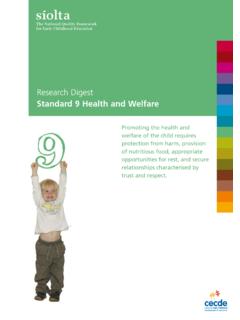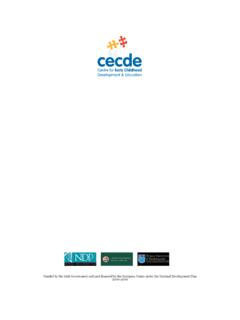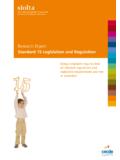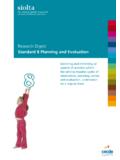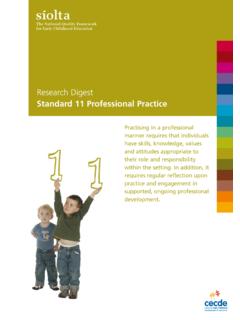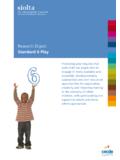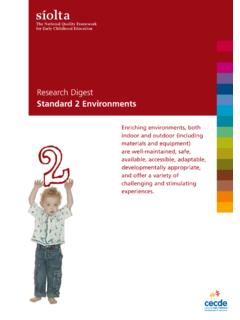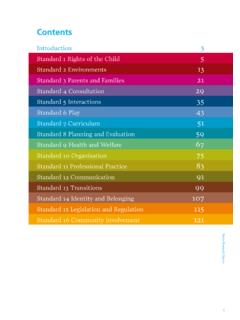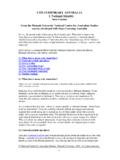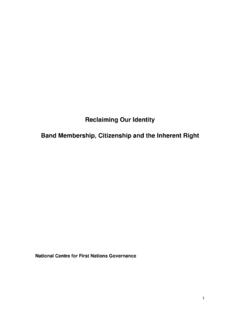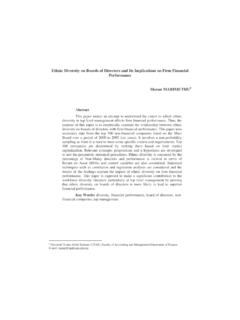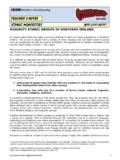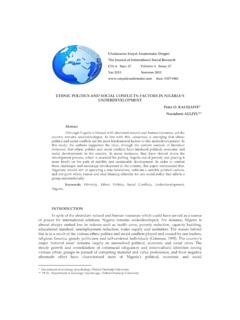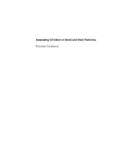Transcription of Research Digest - Síolta
1 The national Quality Framework for Early Childhood Educations oltaResearch Digest Standard 14 identity and BelongingPromoting positive identities and a strong sense of belonging requires clearly defined policies, procedures and practice that empower every child and adult to develop a confident self- and group- identity , and to have a positive understanding and regard for the identity and rights of others. Research Digest s olta identity and Belonging Research Digest s olta identity and BelongingIntroductionIssues of identity and belonging are key to any discussion of childhood development (in particular to the socialisation component) and create strong foundations on which future learning and interaction patterns are predicated ( Research Digest /Standard 5: Interactions). If, for example, children form positive attitudes towards difference from a very early age, they are more likely to grow up appreciating diversity as a normal part of their lives.
2 This kind of learning needs to be reflective of the fact that twenty-first century Ireland is an increasingly pluralistic society. In order to ensure harmony within this multiculturalism, it is essential that children learn from an early age to respect other individuals and groups. As a precursor to tolerance and mutual understanding, it is equally important that each child is given opportunities to develop her/his own sense of identity and belonging. It is, after all, only once a child has an established sense of self that she/he can begin to identify with other children and adults that she/he encounters in the setting on a regular basis. As Smith et al. ( 003:181) conclude a sense of self is used as a reference point for understanding others. identity is a general term for how people think about themselves, and can refer to all aspects of the self physical appearance, personality, ability, age, gender or ethnic group.
3 The concept of belonging is inextricably linked to that of identity , as it is how a person evaluates their importance within a particular setting ( , family, peer group, care setting). In order to feel a true sense of belonging within a setting, for example, a child needs to understand that her/his being there extends far beyond the necessity of parents having to work; the child needs to feel welcome, understood, included and early years setting plays a central role in the promotion of positive identities and a strong sense of belonging among children. After infancy, it is the child s peers that provide the major reference group for children and is often the first point of contact and influence beyond the immediate family. It therefore represents a time of great challenge to the individual child, who continues to develop a sense of self, while simultaneously developing an 3 Research Digest s olta identity and Belongingunderstanding of her/his own emotions.
4 She/he is also learning to categorise others and their emotional expressions. As ever, the practitioner is fundamental to this process. While all the time bearing in mind that how a child feels about her/himself is not innate, but learned, the practitioner needs to ensure that the setting provides a confident self- and group- identity . For both children and practitioners, the sense of who we are (especially when all around us is changing at such a fast pace) is fundamental. Ethnic and racial diversity have powerful consequences for identity . For practitioners and teachers, learning to juggle the multiple realities and often conflicting expectations of a diverse society, is an incredible challenge. The effective practitioner is largely unscripted for such tasks, forced to act and react on the spot as situations arise, and to adapt to the changing needs of her/his particular setting. Recent ResearchIdentity formationIdentity formation is a complex process that is never completed (Siraj-Blatchford, 001).
5 From birth to maturity, a child s standpoint (from which she/he views the behaviours of others and attempts to understand the world around her/him) is constantly evolving. This process of socialisation is central to any understanding of identity , and is dependent on a variety of factors, ranging from nature-nurture to family and peer influences, as well as cultural considerations. These socio-cultural aspects of socialisation are paramount. They highlight the fact that the child is not a constant, universal organism operating in a vacuum but is, instead, an inherently social being. She/he is influenced by her/his immediate contacts, by a particular culture (ideologies, values, attitudes, laws, customs, etc.) and by a diversity of other social influences involving reciprocal relationships ( , what happens at home influences what happens at the setting and vice versa). The development of identity , therefore, primarily comes from experience; children acquire new ideas about themselves and others, and modify old ones, as they encounter their social and physical world (O Dwyer, 006).
6 The image of oneself as a distinct person is crucial in order to establish a sense of identity . Initially, this sense of self is established through ongoing contact with one person, generally the mother figure in a baby s life. Between the ages of nine and twelve months, an infant is capable of distinguishing between pictorial representations of themselves and others they smile more, and look for longer, at pictures of themselves than of other babies of the same age (Smith et al., 003). As the toddler develops into the pre-school years, other people contribute to a broader view of this identity . Through their different behaviours, these people will help a child to know who she/he is. At three or four years of age, the family structure provides the child with a sense of personal continuity, and so has a powerful effect on their sense of identity (Dowling, 000). When a child begins at a cr che or nursery, the practitioner shares this responsibility ( Research Digest /Standard 13: Transitions).
7 They become a further influence on the child s sense of self, and of others, as they teach her/him how to interact, how to establish and maintain friendships, how to manage conflict, and so forth. The reflective practitioner helps each child to build a personal, multiple self-image and a vitally important sense of belonging. This involves understanding how each child thinks and knowing what interests her/him. In order to feel comfortable and have a sense of belonging within a setting, a child needs to know that she/he is known and that her/his behaviour is understood. When children begin attending childcare and education settings, they leave the familiar patterns and values of home life and face a world where there are different people who may do things differently or have different values. This represents further challenges to the practitioner. As Vandenbroeck ( 000:5) concludes: Educators can help children to experience the negotiation between different reference groups.
8 They have this responsibility exactly because they represent the first new milieu that a child experiences outside the home environment. Early childcare is the place where the child will be confronted (probably for the first time) with society s diversity and complexity. An early years setting can create, strengthen and promote positive self- and group- identity in three principal ways (Schellekens, 001) by aiming to: Research Digest s olta identity and Belonging Promote identification by offering recognition, increasing empathy and stimulating curiosity. By exchanging experiences, adventures and emotions, children discover similarities and differences together. They learn that everyone has her/his own identity , own home environment, character, feelings and style of behaviour Increase self-confidence by emphasising everyone s strong points; reflecting on one s own strengths and style forms the basis for a positive self-image and for self-confidence, which in turn can promote mutual understanding and respect Foster insight into feelings and behaviour and the effect this has on others.
9 The themes of various stories and fairytales, for example, can provide a good opportunity for children to talk about what concerns them. In this way, they explore their inner world and that of others. They find the right words to articulate their feelings, enjoy the similarities and accept the differences, without immediately rejecting being different The encouragement of healthy communities who value and understand the influence which early preventative health measures can have on children s well-being ( Research Digest /Standard 16: Community Involvement) Tolerance and mutual understanding Today s Irish society is increasingly heterogeneous and diverse. Accepting the fact that children as young as three-years old are capable of holding and expressing prejudicial attitudes can be quite difficult, but Research shows that this is the case. We now know that young children have an ethnic awareness of cultural identity and they are not only aware of the ethnic group they belong to, but they already attach a value judgment to it (Vandenbroeck, 000).
10 The challenge that confronts practitioners, therefore, is to create a learning environment within which existing prejudices are challenged and the potential for developing such attitudes is undermined. Stressing similarity is insufficient, as it is unrealistic to assume that it will somehow remove the tendency by children to make distinctions between themselves and those from different backgrounds 5 Research Digest s olta identity and Belonging6 Research Digest s olta identity and Belonging(racial, ethnic, religious, social, etc.). Hand-in-hand with an emphasis on similarity, a strategy that can deal sensitively with difference is required. This type of anti-bias approach seeks to nurture the development of each child to her/his full potential by actively addressing issues of diversity and equity in the early years setting. Murray and O Doherty ( 001) classify an anti-bias curriculum as having four specific goals: To nurture each child s construction of a knowledgeable, confident self-concept and group identity To promote each child s comfortable, empathic interaction with people from diverse backgrounds To foster each child s critical thinking about bias To cultivate each child s ability to stand up for her/himself and for others in the face of biasWhen considering diversity within the setting, it is important that the practitioner recognises the role of each adult.
